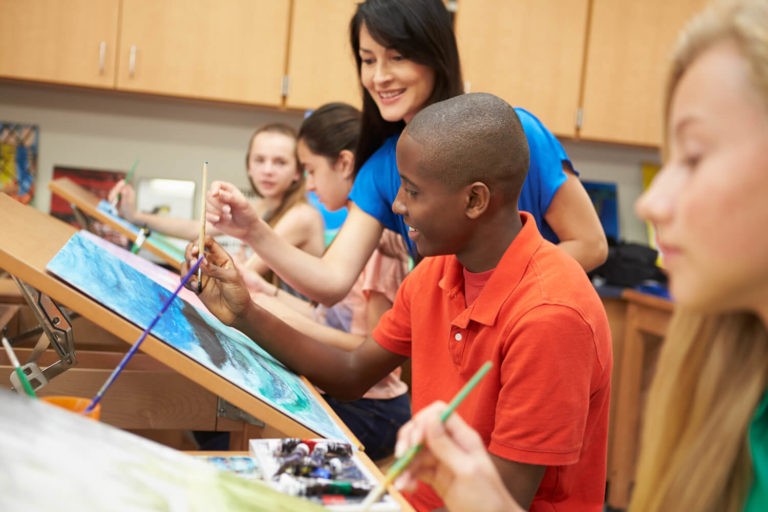The arts are a critical component of a student’s education. Although many view the arts as unnecessary or one dimensional, the arts are extremely multifaceted in that they promote interpersonal skills that are highly beneficial for a student’s success in school and the work place. These skills far transcend just drawing, painting, and performing! Let’s explore how students gain interpersonal skills, like empathy, listening, and cooperation, through the arts.
Developing Empathy
Empathy is an important skill that allows a person to understand the feelings of others. The arts are a form of emotional expression, and they develop the skill of empathy in students by two means: viewing art and creating art.
Viewing Art
The arts create emotional responses in its viewers. Viewing a work of art, listening to a song, or watching a performance can all produce an emotional response. When students watch a performance, the emotion that has been produced on the stage can be felt. After listening to a song, the emotion felt by the performer(s) radiates through the room. Through this, students gain an understanding of what others are feeling or going through.
Creating Art
It also important to note that when students create art (regardless of the medium) they are developing empathy. From painting a picture to singing a song, students use their emotions to enhance the performance. To do this successfully and to make the biggest impact on viewers, students must be “in touch” with what they are feeling.
Why is empathy so important?
Skills like patience, listening, and cooperation develop through empathy. Once students have developed empathy, they are better equipped to collaborate with others using those skills. Because they are now sensitive to the emotions of others, students are more likely to exude patience and listen to those around them more effectively. Empathy allows students to have more successful cooperation with others as they can put themselves in the other person’s shoes, so to speak. Empathy teaches students to be open and fosters their ability to work well with others as they now identify with what their classmates may be feeling.
New Perspectives
The arts open up such a huge world of possibilities! The arts allow students to view different perspectives on topics new and old. One of the greatest benefits of the arts is that its interpretation is left up to the viewer. The way that one student interprets the art will be different from how another student interprets the art.
When students share their different perspectives with one another, their minds are now open to all those possibilities! Students can take this newly found perspective and expand upon it. Not only does this enhance student thinking, it increases student motivation. Because students are not limited in the arts (as they are encouraged to think outside the box and be creative), students will be motivated to share their own perspectives in new and exciting ways.
Communicating through Different Means
Through different mediums of art, students learn to communicate in different ways. Students of all shapes, sizes, nationalities, learning abilities and styles, and more can benefit from communicating through the arts. Students can develop their communication skills through art by selecting a medium to express their viewpoints. Students could paint a picture to communicate, write a song or poem, or create a monologue to act out. All of these help students communicate though different means.
Even those students who are shy, timid, or suffer from a learning disability can successfully communicate with others using the arts. The arts also give students an opportunity to share their voices, be it through visual art or performance art. It is quite exciting to watch students, who would otherwise not participate, flourish when communicating through different art mediums.
Adaptability
Change is inevitable, and students must be knowledgeable in how to handle those changes and self-regulate. Adaptability is defined as one’s ability to adapt to new or unknown situations. It is extremely important that students develop adaptability as they are constantly being faced with changing environments. These skills are equally as beneficial to students as they enter adulthood and begin their careers.
The actual creation of art promotes adaptability. Sometimes, you will need to adapt when creating a song, painting a picture, taking photographs, etc. You may even need to improvise, meaning make use of something unexpected or unplanned, to adapt your art. From this, students develop the ability to adapt to different situations or problems that they may encounter throughout school and life by using the arts. These adaptability skills better prepare students to make adjustments quickly and as necessary in their everyday lives.
Because the arts are a means of emotional expression, students can use the creation of art as a coping mechanism for whatever they are facing. The arts are an outlet for stress relief for so many, and students can use this skill to their advantage to better handle any situation or problem that they may be facing. If students are going through a difficult situation, they may choose to convert those emotions into some type of art. Students could paint a picture, write a song, perform, etc. By using the arts in this manner, students can cope with the situation, manage their emotions, and effectively problem-solve.




